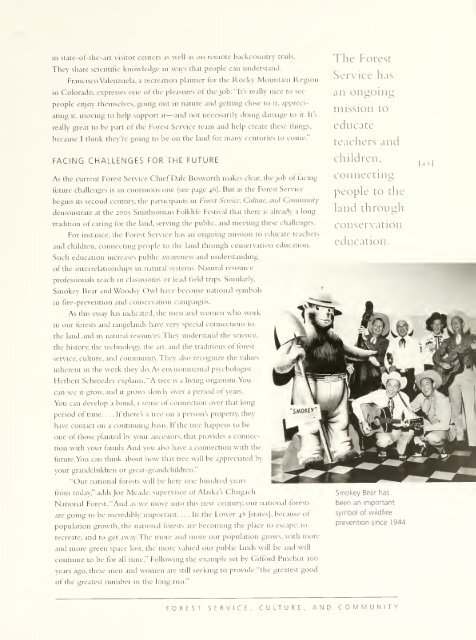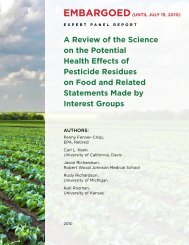I44cutDUTCH OVENONE-POT MEALThomas M. Collins of North Ogden,Utah, retired Forest Service employeeIngredients1 Vi to 2 pounds of small to mediumred potatoes, washed and unpeeled]2 medium heads of cabbage,in wedges3 onions, quartered8 ears of sweet corn on the cob,cleaned and broken in half2 pounds of smoked kielbasa or othersmoked ring sausage, cut into quarters1 quart waterPlace the potatoes on the bottom ofa 12-inch Dutch oven and layer asfollows: cabbage, onion, corn, andsausage. Add water and cover tightly tokeep in moisture. Cook for about onehour, with 10 to 12 charcoal briquetteson the bottom, replacing charcoal asneeded. The smoky juice from thesausage drips down through the otherfood and gives it a good flavor. Servefrom the Dutch oven, or transfer someof the top layers to other containersfor easier access to the potatoes on thebottom. Season to taste. Serves 6 to 8.Rock climbing, hiking, and rappelling are just a few methodsfor bringing people closer to nature in the national forestsPROMOTING RECREATIONRecreation takes many tonus. In communities around thenation, families can join in Forest Service programs thatteach them not only how to fish, but also how to protectfish habitats, protect water quality, operate a boat safely,and practice the principles of catch and release. Enthusiastscan go hiking, biking, bird watching, horseback riding,hunting, skiing, sledding, ice skating, snow shoeing, snowboarding,rock climbing, canoeing, surfing, diving, swimming,or camping— to name a tew. The Forest Servicemaintains trails that range from short nature hikes forphotographers to rugged backcountry trails for backpackers.Thomas Collins explains: Igot this recipeMan\rtrailsare accessible to people with disabilities.from a horse packer in Montana. It isprobably derived from the old cream-candinners that were used by early settlersinNew England and the Midwest whenfeeding large numbers of workers atgrain-threshing bees and other workparties. The food was layered in severalfive-gallon cream cans With the lids on,they were put on the coals of a woodfire to cook. When serving, the food wasgenerally separated. The cook took themeat out (different kinds of smoked meatcould be used), cut it up, and served it soeveryone received some meat. This onepotmeal was a natural for Dutch ovens.Reprinted with permission from CampCooking. WO Years by the NationalMuseum of Forest Service History.Main' people have long recognized the need toleave parts of America undisturbed by humans. The firstwilderness areas in the United States were establishedby the Forest Service in 1920; since then, close to 100million acres of wilderness have been added to the system.The United States has far more acres of wilderness setaside than any other country in the world, and in 2004celebrated the 40th anniversary of the Wilderness Act.In wilderness areas, visitors are united to come, butnot to remain. Programs such as Leave No Trace teachwilderness visitors to pack out their trash, use lightweightstoves instead of making fires, stay on designated trails,control horses, and leave cultural and historical sites alone.1 he forest Service has a cadre of employees whose jobisto talk about the value ot forests, wildlands, and nature.Interpretive naturalists and backcountry rangers are foundSMITHSONIAN FOLKLIFE FESTIVAL
in state-of-the-art visitor centers as well as on remote backcountry trails.They share scientific knowledge m ways that people can understand.Francisco Valenzuela, a recreation planner for the Rocky Mountain Regionin Colorado, expresses one of the pleasures of the job: "It's really nice to seepeople enjoy themselves, going out in nature and getting close to it, appreciatingit, moving to help support it—and not necessarily doing damage to it. It'sreally great to be part of the Forest Service team and help create these things,because I think they're going to be on the land for many centuries to come."FACING CHALLENGES FOR THE FUTUREAs the current Forest Service Chief Dale Bosworth makes clear, the job ot taringfuture challenges is an enormous one (see page 46). But as the Forest Servicebegins its second century, the participants in Forest Service, Culture, and Communitydemonstrate at the 2005 <strong>Smithsonian</strong> Folklife Festival that there is already a longtradition of caring for the land, serving the public, and meeting these challenges.For instance, the Forest Service has an ongoing mission to educate teachersand children, connecting people to the land through conservation education.Such education increases public awareness and understandingThe ForestService hasan ongoingmission toeducateteachers andchildren,connectingpeople to theland throughconservationeducation.45of the interrelationships innatural systems. Natural resourceprofessionals teach in classrooms or lead field trips. Similarly,Smokey Bear and Woodsy Owl have become national symbols- t111 fire-prevention and conservation campaigns.As this essay has indicated, the men and women who work111 our forests and rangelands have very special connections tothe land and its natural resources. They understand the science,the history, the technology, the art, and the traditions of forestservice, culture, and community. They also recognize the valuesinherent in the work they do. As environmental psychologistHerbert Schroeder explains. "A tree is a living organism. Youcan see it grow, and it grows slowly over a period ot years.You can develop a bond, a sense of connection over that longperiod of time. . . . If there's a tree on a person's property, theyhave contact on a continuing basis. If the tree happens to beone of those planted by your ancestors, that provides a connectionwith your family. And you also have a connection with thefuture. You can think about how that tree will be appreciated byyour grandchildren or great-grandchildren.""Our national forests will be here one hundred yearsfrom today,'" adds Joe Meade, supervisor of Alaska's ChugachNational Forest. "And as we move into thisnew century, our national forestsare going to be incredibly important. ... In the Lower 48 [states], because otpopulation growth, the national forests are becoming the place to escape, torecreate, and to get away. The more and more our population grows, with moreSmokey Bear hasbeen an importantsymbol of wildfireprevention since 1944.and more green space lost, the more valued our public lands will be and willcontinue to be for all time." Following the example set by Gifford Pinchot 100years ago. these men and women are stillof the greatest number in the long run."seeking to provide "the greatest goodFOREST SERVICE, CULTURE, AND COMMUNITY
- Page 1: Smithsonianolklife Festival\Food Cu
- Page 4 and 5: The annual Smithsonian Folklite Fes
- Page 7 and 8: —CONTENTSThe Festival's Timely Ap
- Page 9 and 10: —THE FESTIVAL'S TIMELY APPEALLAWR
- Page 11 and 12: COMMERCE FOR CULTUREFrom the Festiv
- Page 13 and 14: [ii]The food concession for the Mel
- Page 15 and 16: oMiiitbioni.indotal SoundL04.A 1 Sl
- Page 17: 1WELCOME TO THE 2005 FOLKLIFE FESTI
- Page 20 and 21: Workers harvest artichokes at Ocean
- Page 22 and 23: —assigned aparticular dish—meat
- Page 24 and 25: I--IPot Pie Farm manager Elizabeth
- Page 26 and 27: ISustainable farmers such as Eliot
- Page 28 and 29: "IThe numberof programsdesignedfor
- Page 30 and 31: .hadSALAD GREENS WITH GOAT CHEESE,
- Page 32 and 33: w.A>wm:~
- Page 34 and 35: —3 3]OCCUPATIONAL CULTUREThe 2005
- Page 36 and 37: employees, the USDA Forest Servicei
- Page 38 and 39: I[3 6]page book, which could fit in
- Page 40 and 41: ká.!i- .>!mKPA backpacker sets up
- Page 42 and 43: --^i'liunterw eight jihI ...itl jib
- Page 44 and 45: —4-"The essentialpiece isto captu
- Page 48 and 49: —FUTURE CONCERNS FOR PUBLIC LANDS
- Page 50 and 51: NUESTRA MÚSICA: MUSIC INBuilding C
- Page 52 and 53: plena groups throughout the Northea
- Page 54 and 55: NUESTRA MÚSICA LAUNCHES NEW SERIES
- Page 56 and 57: NUESTRA MÚSICA: MUSIC IN LATINO CU
- Page 58 and 59: "ILos Camperos de Valles son músic
- Page 60 and 61: RAICES LATINASNUESTRA MÚSICA LANZA
- Page 63 and 64: IOMAN: DESERT, OASIS, AND SEARICHAR
- Page 65 and 66: DESERTThe deserts ot the Arabian Pe
- Page 67 and 68: THE FESTIVAL PROGRAMThe 200s Smiths
- Page 70 and 71: 6 8The coiled, leather-covered bask
- Page 72 and 73: 70]COASTAL CRAFTSMANSHIPAND GLOBAL
- Page 74 and 75: [72]Although the oldismaking way fo
- Page 76 and 77: AN OMANI FOLKTALEASYAH AL-BUALYOman
- Page 79 and 80: y%aMUSIC AND DANCE INOMANOMAN CENTR
- Page 81: In the southern Dhufar region, al-b
- Page 84 and 85: ecosystems, identification of plant
- Page 86 and 87: 2:00IIIVorkshopFESTIVAL SCHEDULE (P
- Page 88 and 89: Rhythm,Saturday, June 25 (Programs
- Page 90 and 91: )avidi nestMonday, June 27(Programs
- Page 92 and 93: 1:00IIlamFriday, July 1 (Programs a
- Page 94 and 95: )utchSunday, July 3(Programs are su
- Page 96 and 97:
EVENING CONCERTSSounds of the Fores
- Page 98 and 99:
theRELATED EVENTS[96]Nuestra Músic
- Page 100 and 101:
IIDónalas Anderson,Washington, D.C
- Page 102 and 103:
'IEd LiíDmi, Studio City, Californ
- Page 104 and 105:
ISudhir Seth, Bethesda, MarylandA g
- Page 106 and 107:
1 if 1 DumberHoneyBeehive Beeproduc
- Page 108 and 109:
1"''NewI >onI Lui\IDon Bustos,Espa
- Page 110 and 111:
Ian Barlow, White Bird,Idaho; Woodl
- Page 112 and 113:
I 'istnet1Gordon Grant,Corvallis, O
- Page 114 and 115:
Kristen Marline, Flagstaff,Arizona;
- Page 116 and 117:
I1 ountries,IIHistorie Site, once t
- Page 118 and 119:
1IworksI1 11Istations are vital to
- Page 120 and 121:
1'IenIpanderetas;JCJ Band. Washingt
- Page 122 and 123:
Ralph Rinzlersongs are "made" (or c
- Page 124 and 125:
I >cmseI VhorahII MiI lameEne Nance
- Page 126 and 127:
|i 2forIIBartlevy1 )oerr;IIParadeSP
- Page 128 and 129:
II AerialIIII1Washington and Jeffer
- Page 130 and 131:
Stack, Bill Stafford, loni Stafford
- Page 132 and 133:
SMITHSONIAN FOLKLIFE FESTIVAL 20051
- Page 135 and 136:
SMITHSONIAN FOLKLIFE FESTIVAL 2005B
- Page 138:
Smithsonian Folklife FestivalSMITHS








